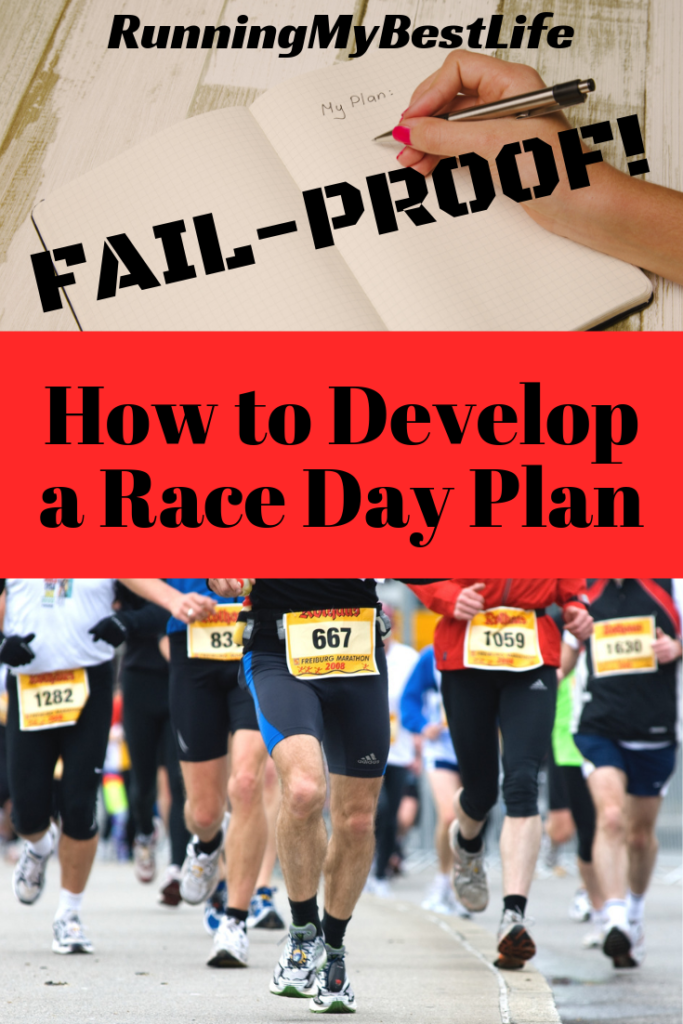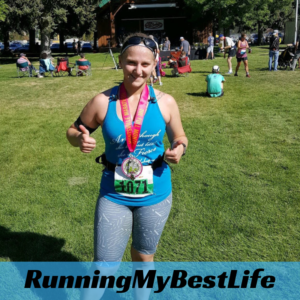In order for your race day to go exactly as planned, you have to HAVE a race day plan.
One of my favorite mantras is, “If you fail to plan, you plan to fail.”
This applies to nearly every area of my life, and I’ll admit that my personality type LOVES to be organized and make a clear plan for EVERYTHING. Since I love running and racing, naturally I love developing a killer race day plan.
[convertkit form=964110]

The Importance of a Race Day Plan
If you have to ask at the race expo, “When should I GU?” then you’re already way behind the ball.
You’ve probably heard the advice: Never try anything new on race day.
This is because race day is the last time you want to try something new. You want everything to go smoothly, without major disruption, discomfort, or change of plans. You want a fail-proof race day.
If you get a new pair of shorts, you’re going to want to try them out on at least 1 training run (better if you can do 2-3 runs in them) before you take them to a race. 5 miles into a half marathon is not the time that you want to find out those stylish new shorts rub you in the wrong way.
Likewise, it would be a real bummer to try out the race sponsor gel for the first time on your race only to discover it causes major stomach discomfort.
You want to test everything from your race morning breakfast, to your outfit, fueling plan, and even your pacing strategy (over a shorter distance) before race day. This way, everything will be familiar when you race and there won’t be unwelcome surprises.
What Happened When I Didn’t Follow My Race Plan
The last time I tried to deviate from my race plan, it nearly ended in an injury. I had signed up for a local half marathon, and since I was already registered for a half marathon the following week, I planned to treat this race as an easy long run.
When I arrived the morning of the race and saw that there was less than 100 people running that day, my ego got the best of me and I decided to see how well I could do. I went out at the same pace that I had run several weeks prior at the Salt Lake City Half Marathon.
In the first few miles, I felt good. I kept up the pace through mile 5, when I noticed that my knee started to feel like I had already run 13 miles. This can’t be good, I thought.
After that, it started to hurt worse. By mile 8, I resorted to mostly walking, and running for short intervals just so I wouldn’t be out there on the course all day. But I knew I wouldn’t be able to run the rest of the race or I would risk injury.
I guarantee you when my knee started hurting, the only thing I could think about is how I wish I would have just stuck with the original plan I had made when I was thinking rationally and before the race excitement got to me.
Plan your race, then race your plan
Learn from my mistake and plan your race while you can remove the influence of adrenalin and emotion from your decisions.
By planning your race ahead of time, you can avoid risky decisions like trying to go out at too fast of a pace for risk of blowing your legs up and having to slow way down later. Or, maybe you’ll skip the opportunity to hydrate at the early aid stations and regret that decision later in the race when dehydration affects your performance.

6 Must-Have Components for Your Race Day Plan
Several components make up a solid race day plan, from beginning to end.
Plan out your outfit, race morning logistics, breakfast, warm-up plan, pacing strategy, fueling and hydration strategy, and post-race recovery before the big day for a more relaxed, successful, and no-unwanted-surprises race.
Race Morning and Post-Race Logistics
For a stress-free morning, plan out your race morning schedule.
Most races start fairly early, so this means you’re going to need to wake up early. Figure out what time you need to set your alarm by estimating how long it takes you to get dressed (plus lay out your clothes and everything you need the night before!), do your morning routine, eat breakfast, travel to the starting area, park your vehicle, and board buses if necessary.
Then add 30 minutes more than you think you need just in case everything doesn’t go as planned. If you get there too early, then you have extra time to warm up or sit in the car and keep warm.
Parking is a big consideration
My last race was in downtown Salt Lake City, and there really wasn’t much for parking. This cost me an extra 15 minutes because the place I planned to park wasn’t available.
Do your research before race morning. If you have to board public transportation (we had to ride Trax up to the starting line in Salt Lake), make sure you know what the schedule is and which train you need to be on.
When planning your race morning schedule, it’s always better to error on the side of being a little early than too late.

This will ease any anxiety about not making it to the starting line on time. I like to plan to be at the starting line about an hour before the race actually starts. Then I have plenty of time to orient myself, go through my warm-up routine, shed layers, and drop my gear check bag.
Race Morning Breakfast
For your race morning breakfast, you want to go with something that’s easy to prepare where you will be before the race. If you’re sleeping at home the night before, this could be pretty much anything. If you’re staying in a hotel or at a friend’s house, your options might be limited to something more portable.
Either way, be sure to eat a breakfast high in carbs to fuel your race that is easy to digest and most importantly, agrees with your stomach. Stomach distress is seriously one of the worst things that could happen on race day, because it’s really not fun at all.
Test out a few different breakfast ideas before your long runs leading up to the race and pick the one that works the best.
Related: 5 Best Pre-Race Breakfast Foods to Fuel Your Half Marathon
Pre-Race Warm-up Routine
Your warm-up routine is important, because you want your muscles to be primed and ready to start racing the moment you cross the starting mat. For longer races like half marathons and full marathons, you usually take the first few miles slow, but most people don’t want to stop in the middle of a race and take time to stretch while the clock is ticking.
Do 5-15 minutes of really easy jogging to warm-up your muscles before you toe the starting line. I like to throw some dynamic stretching in as well.
My favorites are the monster walk (where you swing your leg straight out in front of you and reach to touch your toe at the same time), slow motion butt-kicks, and a few lunges and squats sprinkled in. This usually does the trick to get me ready, and then I do static stretching if anything is feeling tight.
After my warm-up, I shed my extra layers (it’s usually cold at the starting line), make sure I have all of the gear I need, and put everything I don’t need in my gear check bag to drop with the volunteers.
Related: What is a Gear Check Bag and What You Need to Pack
Plan Your Pace, Then Execute
PLANNING YOUR PACE IS SO IMPORTANT!
Ok, so I’ve said most of these are “so important,” but it’s true! Everything works together in concert for an awesome race day. I hate to sound like a Debbie-downer, but if any one of these elements goes dramatically wrong, it could really ruin your race and your day.
The last time this happened to me was not too long ago. Actually, just a week ago when I decided to treat a “training” race like a real race last minute and completely deviate from my plan.
BAD. Don’t do what I did.
I ended up walking quite a bit during the second half of the race because my knee started to hurt. And I was supposed to run this race slow from the start!
Lesson learned: Always start slower than you think you’re going to go, then speed up after the first few miles if you’re feeling good.
Don’t get caught up in starting line adrenaline
Plan out ahead of time which pace you want to start the race at.
This might be 15 seconds or so slower than your race pace. Force yourself to relax and take the start easy, because most people make the mistake of going out too fast.
You SHOULD feel like you’re going WAY too easy at the start.
Let all the fools (or maybe they’re just faster than you and know they can hold that pace?) pass you at the start. You’ll pass the fools in a few miles when they slow down from early burnout and you’re plugging along at your steady pace because you planned it out ahead of time and didn’t let your emotions take over at the starting line.
Related: How to Pace Your Half Marathon with 4 Simple Strategies
By planning your pace beforehand and sticking to that plan, you create and execute a more logical plan without emotion clouding your judgement.

Race Nutrition: What to Use, When, and How Much
Race day fueling is one thing that you really need to start practicing early on your long runs to allow some time for trial and error.
Running makes all of our stomachs more easily upset and asking your body to digest carbohydrates while in the act of running hard is like throwing gasoline on an already huge bonfire.
It’s a sensitive situation. Thus, it requires quite a bit of trial and error.
The fact that you probably need to consume more carbohydrates than you think you need for optimal performance complicates the situation even further.
Most people use some combination of sports drink, gels or real food, and water.
If you’d like to go really in-depth on the topic of race nutrition, Matt Fitzgerald’s book, The New Rules of Marathon and Half Marathon Nutrition is a FANTASTIC read and well-worth your time.
Or, if you just want the quick-and-dirty guidelines, here they are:
- Consume 30-60 grams of carbohydrate per hour during your race but aim closer to 60 grams if your stomach will tolerate it. Remember this is PER HOUR, so multiply based on how long you expect your race to last. If you’re using primarily gels, this ends up being 1 gel every 30 minutes, or slightly longer if your stomach can’t handle it that soon.
- You can supplement the gels and increase your carbohydrate by carrying your favorite sports drink in a hydration belt. For gels, my favorites that sit well in my stomach are Honey Stinger and Huma gels.
- Drink fluids according to thirst but start early so you don’t get behind and dehydrated. Most people drink 13-27 fluids per hour when they drink according to thirst. Basically, grab something at every available aid station. My favorite drink that I always carry with me on long runs and in races is Nuun Endurance.
Related: 3 Powerful Fueling Strategies for Your Next Half Marathon
[convertkit form=876847]
Plan Your Race Recovery: What to Do When You Cross the Finish Line
When I ran my first half marathon, I was just focused on getting to the finish line. I had put ZERO thought into what happens after the race. Welp, that was a huge mistake…because I spent the following week being so sore it hurt to walk.
When I planned my recovery for my second half marathon, I was able to ease back into my workout routine within a few days.
4 Tips for Post-Race Recovery
- Start hydrating as soon as you cross the finish line with a zero or low-calorie drink. I’m big on Nuun Sport and Nuun Rest right now!
- Within 30 minutes of crossing the finish line, drink a protein recovery shake designed for runners. Herbalife24 Rebuild Strength is the perfect recovery drink after a hard run.
- Keep walking and stretching for at least an hour after you cross the finish. This will help flush the lactic acid out of your muscles and prevent cramping.
- Schedule a easy active recovery days during the week following your race. You might not be back to 100% until a week later, but it’s better than not being able to walk at all for a week. Do things like biking, swimming, yoga, or walking the dog…but the key is to keep it really easy.
Related: Recovering from a Half Marathon Sucks: Here’s How to Make It Suck Less
How do you outline your race day plan?

Run Happy,
Alexis
- Nailing Your Marathon Hydration Strategy: A Comprehensive Guide
- Conquering Marathons in the Cold: A Comprehensive Guide
- Harnessing the Power of Technology for Successful Marathon Training
- Mastering the Marathon: The Ultimate Guide to Nutrition and Training
- Ultimate Guide to the Top 5 Running Shoes for Beginners in 2023
About Me: I’m Alexis, Founder of RunningMyBestLife! I am an avid recreational runner, half marathoner, wife, dog mom, busy professional, downhill skier in Northern Utah. My mission is to help new enthusiasts fall in love with the sport of running. I believe that running is a catalyst to taking control of your life and living your best life by design. Learn More –>